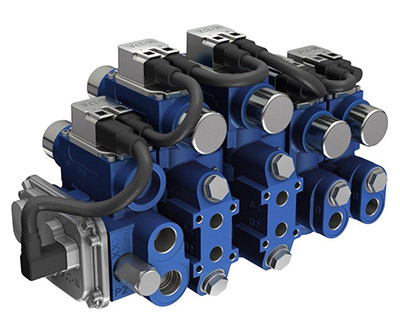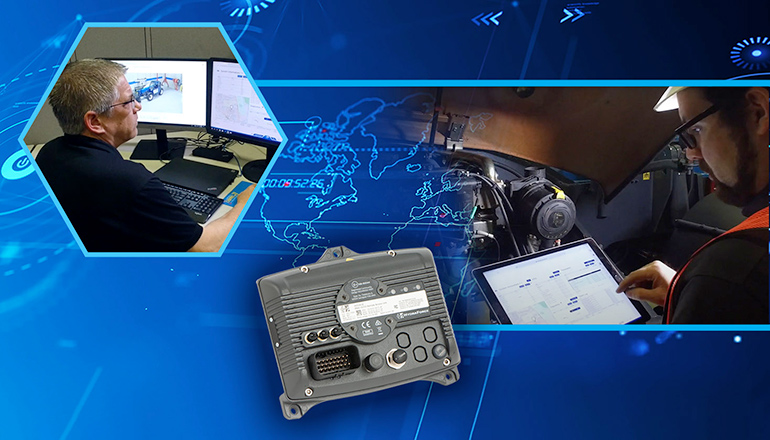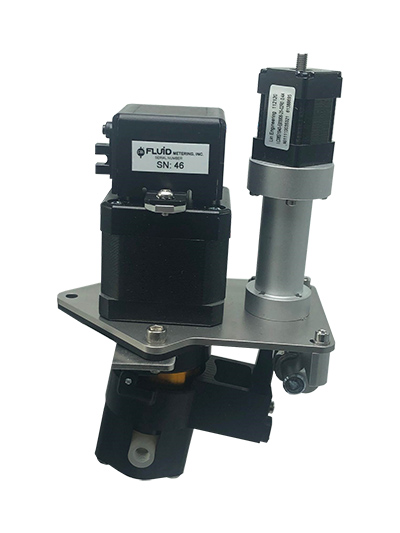Winners of the 2021 LEAP Awards (Leadership in Engineering Achievement Program) were announced this afternoon in a digital ceremony, with products across 12 categories. This annual competition saw a record number of submissions, as it aims to celebrates the most innovative and forward-thinking products serving the design engineering space. This year’s winners were chosen by an independent judging panel of 12 engineering and academic professionals.
Of note, two technologies geared towards mobile machinery notched the silver and bronze awards, with a liquid dispensing pump taking the gold.

For the bronze award, Eaton (now part of Danfoss) was recognized for its CMT valve section for the CMA advanced mobile valve. The CMT section uses a twin-spool architecture to control two separate machine functions independently. It provides
highly accurate meter-in flow control and is software configurable. Features include CAN communication, onboard sensors, digital flow sharing, and electronic load sensing, which provide precise flow control and high responsiveness.
By controlling two machine services from one section, instead of the one service that’s typical of sectional valves, CMT can reduce the total number of sections needed in a valve bank by as much as 50%, minimizing valve bank size and weight.
The CMT section’s greatest advantage is that it enables OEMs to tailor the high-tech CMA valve for all vehicle requirements: CMA sections can be used for services that demand superior precision and control, while streamlined CMT sections can be used for standard machine functions. The availability of two stackable section options enables OEMs to reduce overall system cost without sacrificing performance.
The CMT valve section is ideal for hydraulic services such as bucket, clamping, extension, outriggers, and auxiliary functions on
mobile machinery.
In 2016, Eaton introduced the CMA advanced mobile valve. Featuring independent metering, on-board electronics and advanced control algorithms, the CMA valve can solve longstanding mobile machine challenges such as boom stability, feed force control and more.
A challenge with the CMA valve, like most high-tech products, is its price point. In addition, the CMA valve’s precision and control is not required on every machine service. Think of an aerial fire engine, for example. With a CMA section serving the boom, firefighters can deploy the ladder faster, achieve greater placement accuracy, and significantly reduce boom bounce. This
advanced functionality is not required for the truck’s outriggers —a more standard level of control is sufficient
.
Prior to the introduction of CMT, every service on that fire truck had to use a CMA section, regardless of whether it was needed.
Now, with the availability of the CMT section, machine designers can tailor the valve for each machine function. Services that require the superior precision and control of independent metering , such as the fire engine boom, can use CMA. Services that require only accurate meter-in control, such as the outriggers, can use CMT.
The capability to stack the two section options, combined with CMT’s ability to control two services from one section — which can reduce the total number of sections needed — lowers the price point of the CMA valve, making it a more feasible option for mid-range machinery.
Several hydraulic suppliers offer CAN-enabled mobile valves. If a valve bank comprised only CMT sections and no CMA sections, the resulting valve would be akin to these competitive products. The advantage, however, is the ability to stack CMT sections with high-tech CMA sections. Considering a valve comprised of CMT sections only, CMT offers three distinct benefits over competitive CAN valves:
- Digital flow sharing. While CMT is technically a pre-compensated valve section, control of flow sharing is managed through software. Users can configure how the valve should behave in pump saturation conditions using Eaton’s Pro-FX Configure software. Flow sharing in competitive CAN valves is handled mechanically.
- High speed. CMT is very fast, with a typical step response of 24 milliseconds.
- Factory flow calibration. Typically when a command is sent to a valve, the message is a proportional signal which has no absolute relationship to actuator speed; the machine integrator must calibrate each valve section to each machine function in both directions for every machine they build. With CMT (and CMA), this calibration step is completely eliminated. Instead, the OEM command can be sent in terms of actual units of flow in liters per minute. This makes the valve much easier to integrate and control because it is more repeatable.

Garnering the silver award was HydraForce with its IoT capabilities. HydraForce’s IoT Solutions has changed the landscape for servicing mobile hydraulic equipment. Traditionally, software updates and support for a fleet vehicle or machine would require a trip to the field from a service technician or engineer. The development of IoT solutions allows for internet connectivity of mobile equipment to the cloud, making it possible to operate vehicles remotely, plus perform machine telemetry and analysis – all in real time.
HydraForce partnered with Epec Oy to offer IoT and telematics products for mobile hydraulic equipment applications. It includes Epec’s GlobE and GatE cloud-based service plus the new HydraForce ERAU 6200 remote access unit that can be paired with HydraForce electronic control units (ECUs).
TheHydraForceERAU-6200 is the communication link that processes data between GlobE and GatE and mobile machinery. This versatile remote access unit has multiple use cases, including:
- Logging and analyzing machine data
- Continuousc ondition monitoring of machinery
- Optimizing use of resources
- Machine tracking/geolocation
- Remote desktop control of machine calibration
- Smartphone access to machine controls, operator and service manuals
HydraForce’s IoT solution reduces fleet service costs and improves uptime of mobilee quipment. It may be retrofitted to existing machinery already equipped with electro-hydraulic controls. And it allows new equipment manufacturers to build in this capacity paired with a HydraForce premier hydraulic control solutions package.

Technology is advancing the way equipment is operated and serviced. HydraForce IoT improves machine efficiency by providing crucial data to fleet operators. Continually monitoring performance allows for preventative maintenance to take place before equipment fails.
Finally, in first place with the gold was The FMI Variable Dispense Pump (FVD Series), from Fluid Metering Inc., which combines the function of priming, flushing and dispensing into one device, providing accurate and repeatable dispense volumes of 2 μL to 200 μL in a small lightweight package. The innovative, compact design offers unparalleled accuracy and precision with an electrical and mechanical upgrade that can dispense multiple volumes with the same pump.
From medical devices and biotechnology to diagnostics and analytical devices, there is no shortage of advantages when it comes to the FVD Pump with Cerampump technology.
Filed Under: IoT, Mobile Hydraulic Tips, News, Valves & Manifolds
